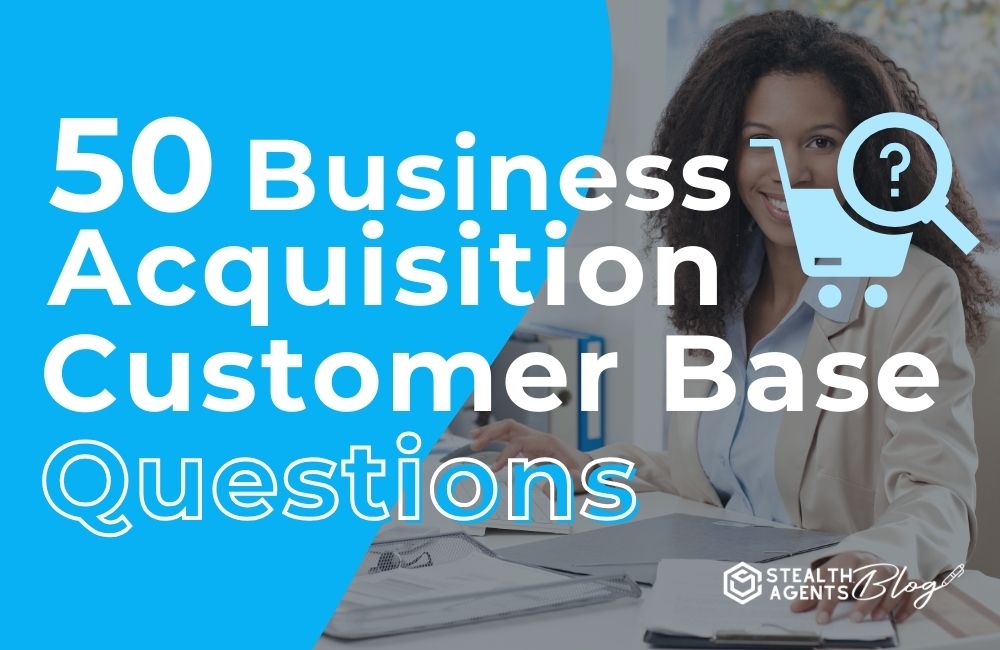Approaching a business acquisition can sometimes feel like planning an expedition to a new world. Among all the due diligence, market analysis, and financial forecasting, there’s one cardinal truth—customers are the lifeblood of any business. Their loyalty, preferences, and buying habits are a treasure trove, ripe for understanding to ensure a smooth transition and successful integration.
This listicle is your compass in the uncharted waters of customer base acquisition. It’s designed for the intrepid business leader, the strategic HR professional, or the courageous team leader about to embark on the acquisition journey.
The Customer Base: Why Does it Matter?
Before diving into the list of questions, let’s understand why the customer base is pivotal in a business acquisition. The customer base isn’t simply a ledger of names; it’s a repository of invaluable data, insights, and best of all, potential.
A solid customer base dictates:
-
The revenue trajectory
-
Brand reputation
-
Market positioning
-
Product innovation needs
-
Future marketing strategies
The Ultimate 50 Questions
Every customer base is unique, and it’s the nuance of these questions that can turn a good acquisition into a great one. Here, the focus is on being exhaustive, not exhausting—dive in where you need the most clarity and let the other questions steer the breadth of your inquiry.
Understanding the Customers
Demographics and Psychographics
- Who are your core customers — demographically speaking?
- How does this correspond with your existing customer profile?
- What are the dominant psychographic traits of your customer segments?
- How do these traits influence their purchasing decisions?
- Are there cultural nuances in customer behavior that we need to be aware of?
Customer History
- What’s the lifespan of your average client?
- Do you have high turnover or are your customers long-standing?
- What have been the historical peaks and troughs in customer activity?
- How do outside factors, like seasonality, impact buying patterns?
- Have there been any high-profile customer losses, and have these been addressed?
Customer Loyalty and Satisfaction
- How do you measure customer satisfaction?
- Can we address any areas of dissatisfaction and turn them into strengths?
- What’s the customer retention rate by each of our leading products or services?
- Is there customer loyalty towards certain employees, and how do we ensure continuity post-acquisition?
- Are there existing customer incentive programs we need to be aware of, and how effective have they been?
Technological and Service Channels
- What are the preferred channels that your customers use to interact with your business?
- Have there been any recent changes in channel preference?
- How often do customers expect service updates and communication, and through what channels do they prefer to receive them?
- Have there been any technology or service disruptions that significantly impacted customer satisfaction?
- Are there new technologies we are considering implementing that may disrupt the current service flow?
Market and Competitive Analysis
Market Potential
- What’s the estimated size of the customer base that we’re acquiring?
- What market share does this represent, and how might it change?
- Are there underserved customer segments with unfulfilled needs that we could capitalize on?
- What is the forecasted growth of our acquired customer segments?
- How do the local economic conditions in the customer’s area currently influence consumer spending?
Competitive Landscape
- Who are the key competitors in the markets we will be serving?
- What distinguishes our offerings from those of our competitors?
- How have competitors historically reacted to market shifts and competitive activity?
- What is the competitive pricing strategy and how is it perceived by customers?
- Are we acquiring any underutilized patents or technological assets that can be harnessed to strengthen our competitive position?
Marketing and Customer Relations
Brand Perception and Adherence
- What’s the public perception of our brand and how does this align with the company’s mission?
- Can we enhance any areas of our existing brand that will be critical to maintaining customer loyalty?
- What are our customers’ associations with our brand and how powerful are they?
- Are there other brands in the customer’s mind space that we should be concerned about?
- How can we use the acquisition to reinforce our brand message with customers?
Marketing Strategies
- What marketing tactics have been most successful in reaching and converting customers?
- Are there key performance indicators (KPIs) tied to each marketing strategy?
- Have non-traditional marketing channels, like influencer partnerships, been explored?
- How well do our customer acquisition costs (CAC) compare to industry standards and competitors?
- Will our current marketing team need augmenting, and if so, to what extent?
Financial and Legal Considerations
Revenue Flows
- What are the primary revenue sources within our new customer segment?
- Are there any payment trends or sources of unpaid invoices that need addressing?
- What’s the average revenue per user/customer, and has this been increasing or declining?
- Is there significant revenue from recurring or subscription-based services?
- Are there changes in pricing structures that may need reevaluating?
Legal Compliance and Customer Contracts
- Do we have access to all customer contracts and are they transferrable?
- Are there any legal disputes with customers that need resolution?
- What’s the overall burden of compliance for our customer base?
- Can we identify any potential compliance issues with the customer base?
- Are there existing conditions in contracts that require immediate attention post-acquisition?
Conclusion
Acquiring a new customer base is akin to adding a new chapter to a novel—you have to ensure a smooth transition without losing the essence of your tale. These questions provide a blueprint, but the most crucial question lies with you and your team: How will you infuse your strategy with the unique spirit of the customer base you’re about to embrace? Engaging with every facet of this journey, from customer history to financial analysis and beyond, will not only solidify your foundation but also illuminate the path forward.
Remember, every acquisition is a two-way street; while you’re exploring the untold potential of a new market, your customers are also sizing you up. Your approach must blend respect for the current narrative with your own authentic voice. Achieve this delicate balance, and the acquisition won’t just be another business milestone—it will be a chapter in your company’s legend. Happy acquiring!











